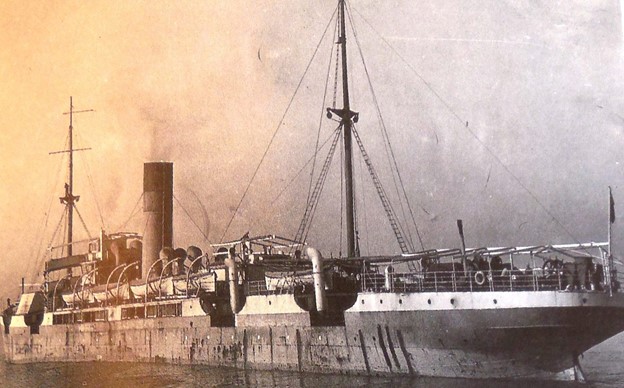On May 30th every year we commemorate the arrival of the Indian indentured immigrants on the Fath al Razack on Friday May 30th, 1845. Less is said however about the last ship to arrive with Indian Indentured immigrants, the S.S. Ganges on April 22nd, 1917.

The S.S. Ganges
Source: The National Archives of Trinidad and Tobago. Nelson Island and Indian Indentureship in Trinidad. https://natt.gov.tt/sites/default/files/pdfs/Nelson-Island-and-Indian-Indentureship-in-Trinidad_02.pdf
The S.S. Ganges belonged to the James Nourse Shipping Company, which was awarded the contract for transporting indentured Indians to the Caribbean in 1875. The Ganges was a steamer ship and voyages from India to the Caribbean could take up to 13 weeks on steamers (Mahase, 2015). The Ganges left India on March 8th, 1917. It left Calcutta with 124 persons, only a third of its intended contingent. The next stop was Madras to pick up more indentured Indians. From there it proceeded on its journey to the Caribbean. The Ganges arrived in British Guiana on April 18th, 1917 and 437 Indians disembarked and were assigned to work on plantations (Shah, 2017). The next stop was Trinidad, and it arrived there four days later.
The following is a breakdown of Indian immigrants who arrived on the SS. Ganges when it docked at the Immigration Depot on Nelson Island in 1917:
No. of persons | Category by age and sex |
274 | Men |
115 | Women |
12 | Boys |
10 | Girls |
10 | Infants |
*7 persons died during the voyage. | |
Total: 421 persons | |
Table showing breakdown of Indian Immigrants aboard the S.S. Ganges, April 1917.
Source: National Archives of Trinidad and Tobago, General Register R Ganges 22 April 1917. https://natt.gov.tt/sites/default/files/pdfs/General%20Register%20R%20Ganges%2022%20April%201917.pdf

General Register 1916-1917 showing the Indians immigrants who arrived on the Ganges on April 22nd 1917
Source: The National Archives of Trinidad and Tobago. General Register R Ganges 22 April 1917. https://natt.gov.tt/sites/default/files/pdfs/General%20Register%20R%20Ganges%2022%20April%201917.pdf
The Indians who arrived on the Ganges in April 1917 were assigned to some of the following estates:

Diagram showing some of the estates that the Indentured Indians from the Ganges were assigned to

A closeup of Register R, showing the personal details of the arrivals on the Ganges
Source: The National Archives of Trinidad and Tobago. General Register of Indian Indentured Labourers. https://natt.gov.tt/sites/default/files/images/General-Registers-of-Indian-Indentured-Labourers.pdf
This was a significant event in the history of Trinidad and Tobago as it was the last ship to bring Indians not just to Trinidad but to all the British West Indian colonies. From 1845 to 1917 approximately 147,600 Indians were introduced to Trinidad. However, it signalled the impending end of the indentureship system. The British West Indian colonies that were importing Indian labourers had no say in the end of the system. The decision that was made was ultimately driven by British interests. India was also a British colony at the time.
Recruitment of Indians for the indenture scheme overseas was suspended on March 12th, 1917 because of the military effort of the First World War (1914-1918) where ships were utilized for the war. The India’s Defence of India Act, 1917 stopped the recruiting process and it never resumed after the war ended. When the S.S. Ganges left India on March 8th, 1917, it escaped the passing of the Abolition Act by merely four days.
The campaign to end indentureship actually began in the late 19th century with the Indian middle classes. Mohandas Karamchand Gandhi inspired huge protests against several issues and Indian indentureship overseas was one. The movement grew as the Indian nationalists joined in the campaign against indentureship as well. After WW1 anti-indentureship protests were widespread across India. The British Imperial Government and the colonial Government of India gave in to the public pressure to end the system. Indian indentureship finally came to an end on January 1st, 1920, meaning that all existing contracts were ended prematurely. All contracts for indentured Indians in all colonies, came to an end on this date and everyone was free to make their lives on their own.
Sources:
Mahase, Radica. (2015) A Brief Look at the Indian Indentureship system in Trinidad. YATRA, East Indian Cultural Promotions.
Mahase, Radica. (2017). Facebook.
The National Archives of Trinidad and Tobago. General Register of Indian Indentured Labourers. https://natt.gov.tt/sites/default/files/images/General-Registers-of-Indian-Indentured-Labourers.pdf
The National Archives of Trinidad and Tobago. Nelson Island and Indian Indentureship in Trinidad.
The National Archives of Trinidad and Tobago. General Register R Ganges 22 April 1917. https://natt.gov.tt/sites/default/files/pdfs/General%20Register%20R%20Ganges%2022%20April%201917.pdf
Shah, Ryan. (2017). The Last Ship. Guyana Times. https://guyanatimesgy.com/the-last-ship/

